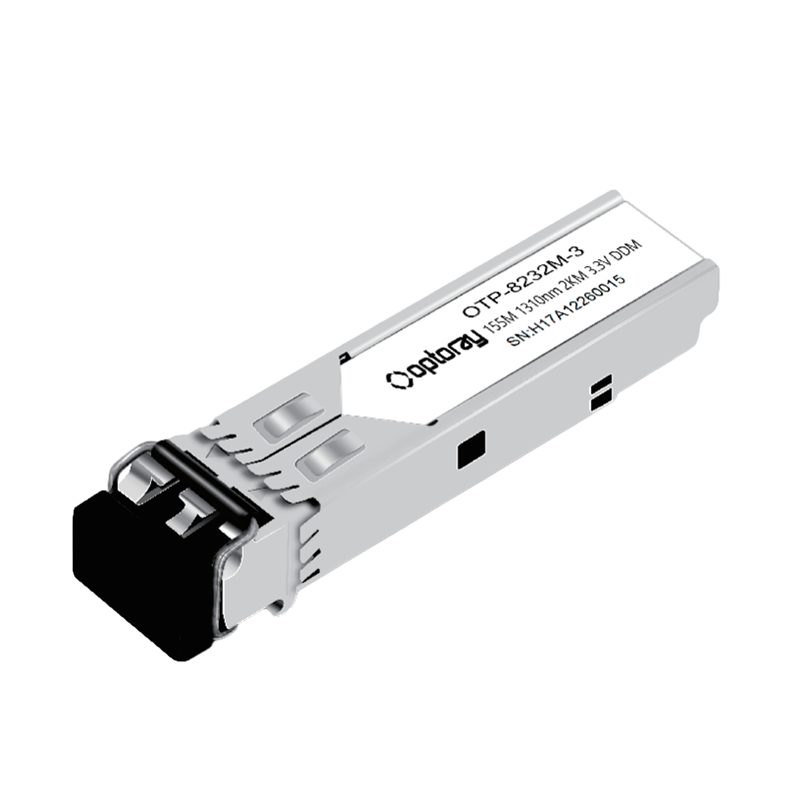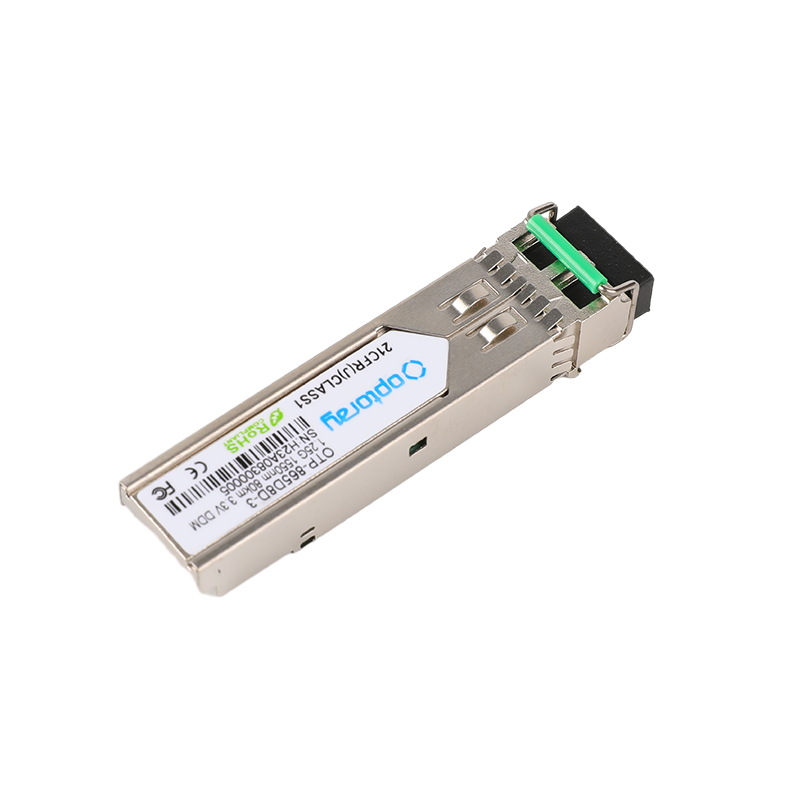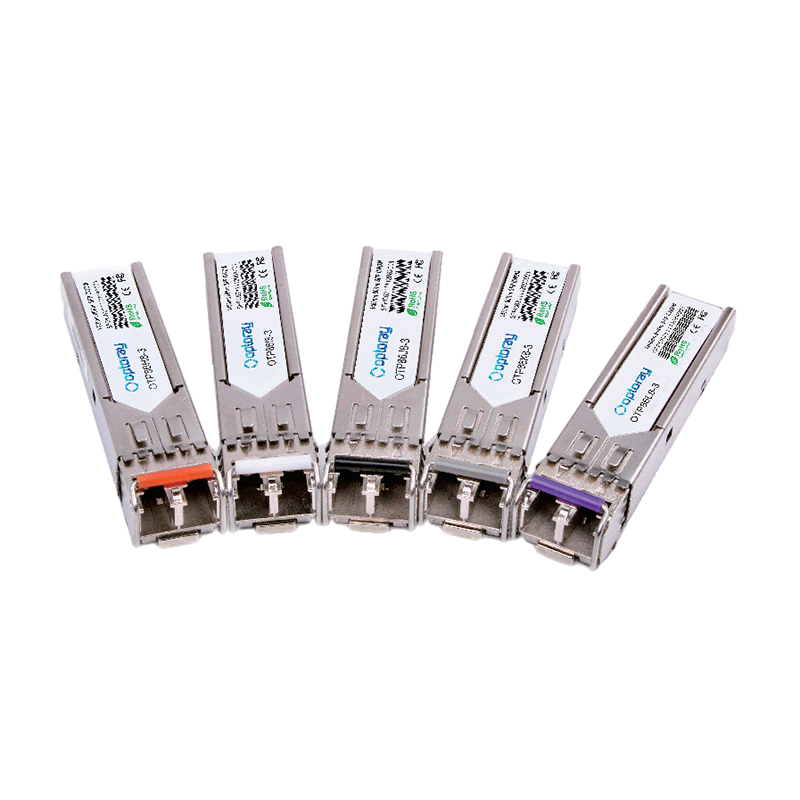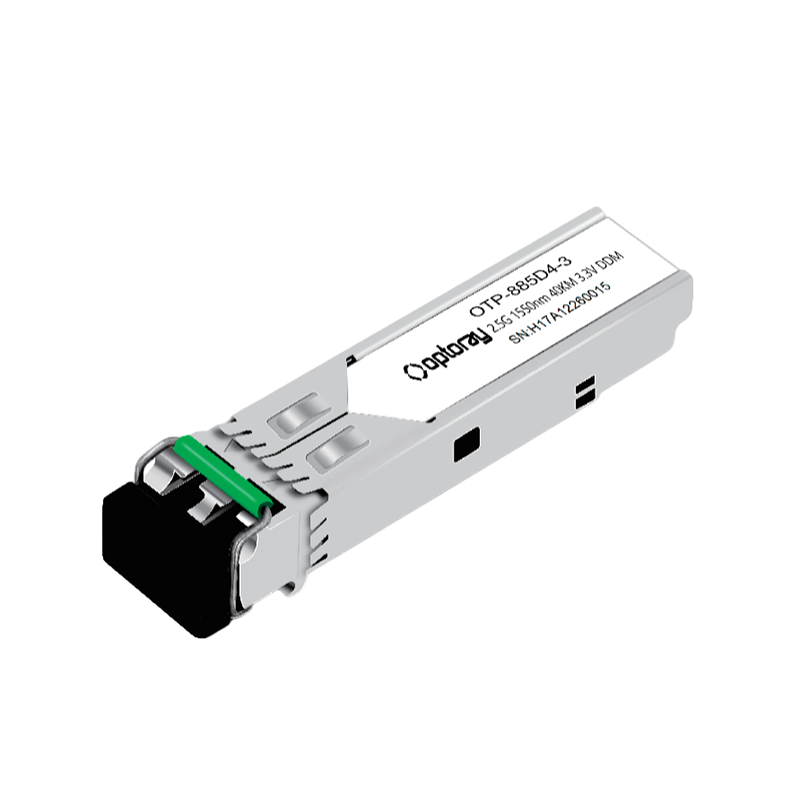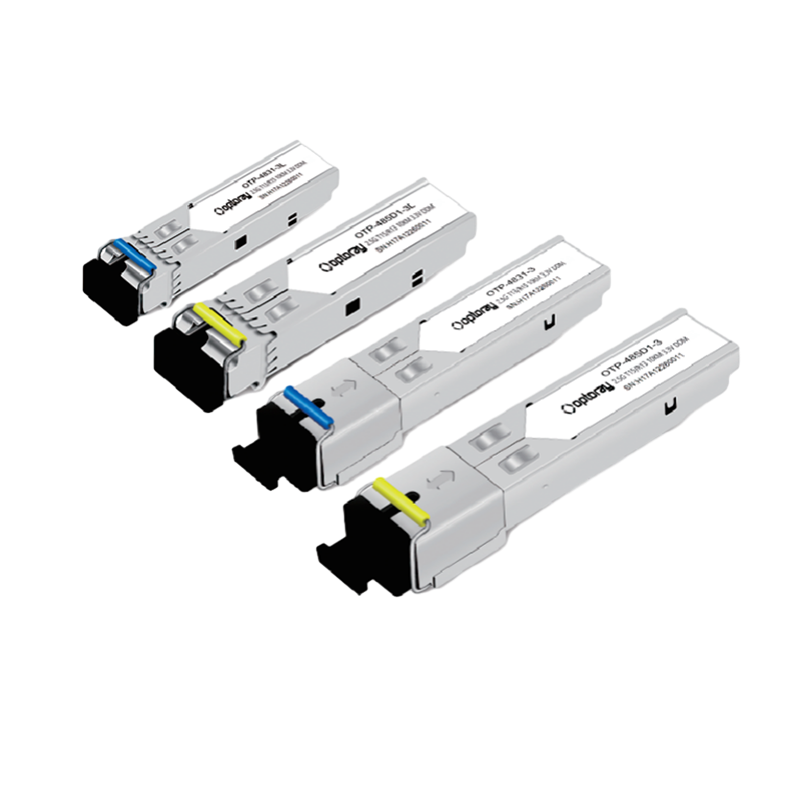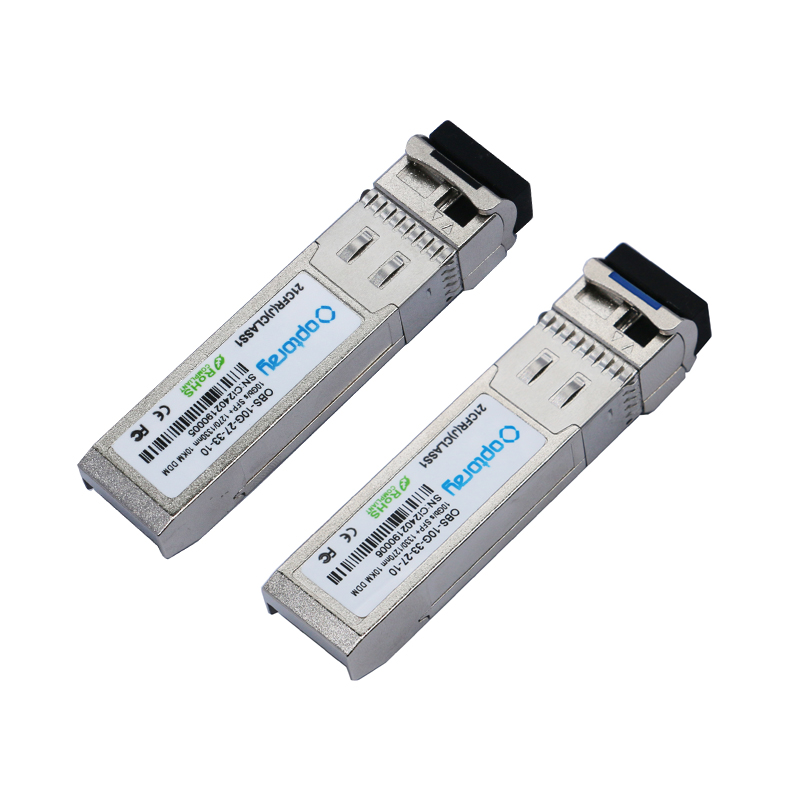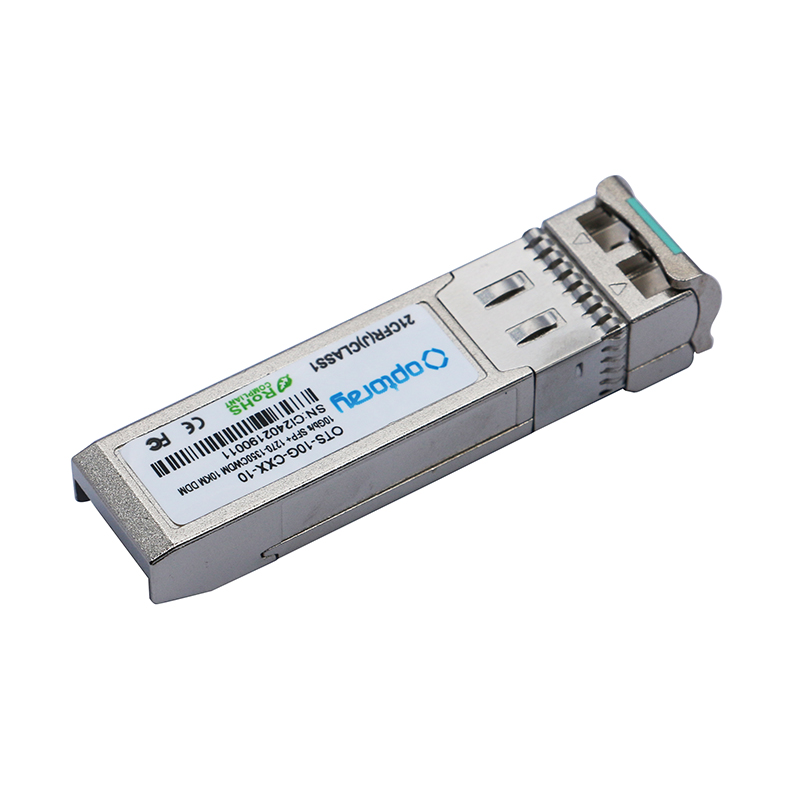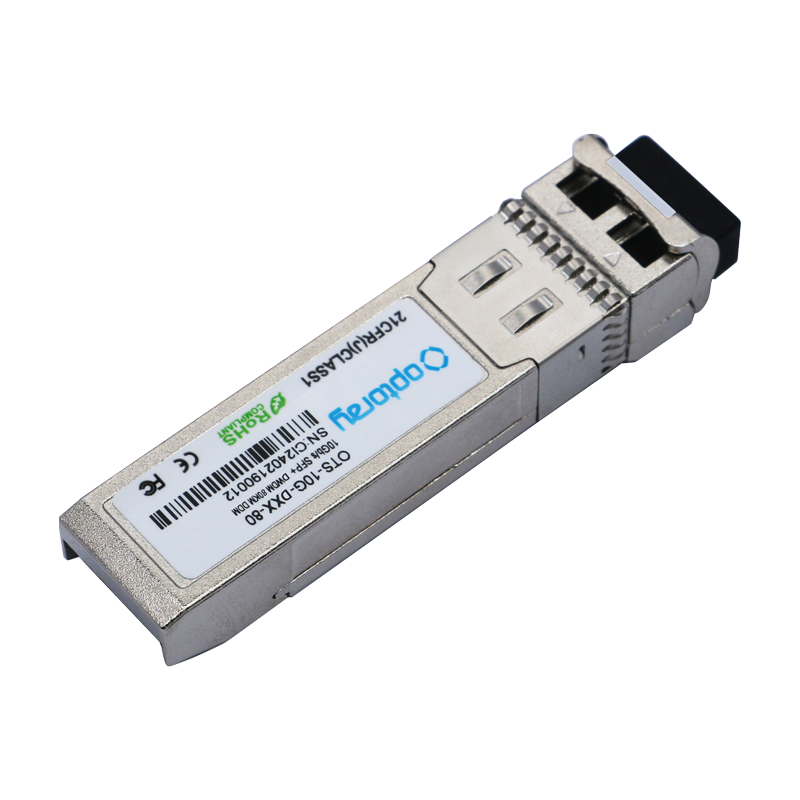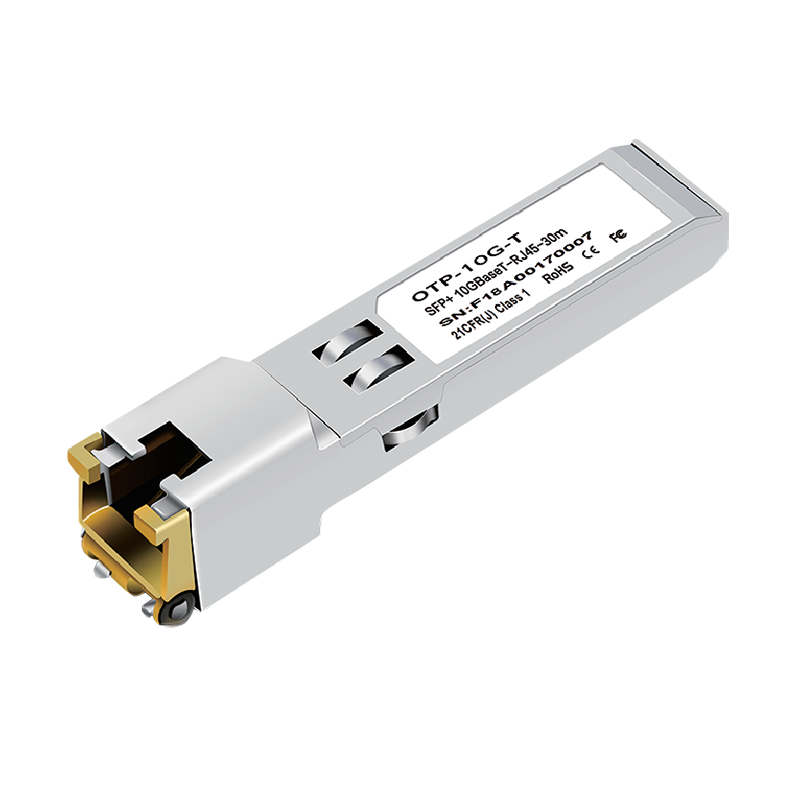+86-0559-5290604
SFP Modules: Powering the Traffic Flow of Modern Networks
I. Introduction to SFP Modules
A. Hook: The Backbone of Modern Networking
In the intricate web of modern digital communication, where data flows at the speed of light, there are unsung heroes working tirelessly behind the scenes. Among these, the Small Form-Factor Pluggable (SFP) module stands out as a critical component, quietly enabling the high-speed connectivity that powers everything from vast data centers to your everyday internet experience. Often overlooked, these compact transceivers are, in essence, the backbone of contemporary networking.
B. What is an SFP Module?
An SFP module is a compact, hot-pluggable optical transceiver used for both telecommunication and data communication applications. Its primary purpose is to convert electrical signals into optical signals (and vice-versa) to facilitate data transmission over fiber optic cables, or to provide copper connectivity.
1. Definition and Purpose: At its core, an SFP module is a miniature Gigabit Interface Converter (GBIC) that allows network devices like switches, routers, and network interface cards (NICs) to connect to various fiber optic cables or copper cables. It acts as an interface, enabling data to travel over different physical media.
2. Key Characteristics:
- Hot-Pluggable: SFPs can be inserted into or removed from a network device without powering down the system, minimizing downtime and simplifying maintenance.
- Compact: Their small size allows for high port density on network equipment, making them ideal for space-constrained environments.
- Versatile: SFPs support a wide range of network standards, data rates, and distances, making them adaptable to diverse networking needs.
C. Brief History and Evolution (from GBIC to SFP and beyond)
The SFP module emerged as a successor to the larger Gigabit Interface Converter (GBIC) transceiver. While GBICs were effective, their bulky size limited port density on network equipment. The industry's push for miniaturization and higher efficiency led to the development of the SFP, which offered the same functionality in a significantly smaller footprint. This evolution marked a pivotal moment, allowing network manufacturers to design more compact and powerful devices. The SFP's success paved the way for even faster and more advanced transceivers like SFP+, QSFP, and OSFP, each pushing the boundaries of data transmission speeds.

D. Importance in Today's Network Infrastructure
In an era defined by massive data consumption and the demand for instantaneous communication, the importance of SFP modules cannot be overstated. They are fundamental to:
- Scalability: Enabling networks to easily expand and adapt to growing data demands by simply swapping modules.
- Flexibility: Allowing a single network device to support various types of connections (e.g., short-range fiber, long-range fiber, or copper) by changing the SFP.
- Reliability: Providing robust and high-performance links essential for critical applications in data centers, enterprise networks, and telecommunications.
Without these small, yet powerful, components, the high-speed, flexible, and efficient networks we rely on daily would simply not be possible.
II. Understanding SFP Module Basics
A. Anatomy of an SFP Module
An SFP module, despite its small size, is a sophisticated piece of engineering comprising several crucial components that work in concert to facilitate data transmission.
1. Transceiver Components (Transmitter, Receiver): The heart of an SFP module lies in its transceiver components. On one side, there's a transmitter (Tx) that converts electrical data signals into optical light pulses using a laser diode (for fiber optics) or electrical signals for copper. On the other side, a receiver (Rx) detects these incoming optical light pulses or electrical signals and converts them back into electrical data signals that the network device can understand. This dual functionality is why they are often referred to as "transceivers."
2. Electrical Interface: This is the part of the SFP module that plugs directly into the host network device (e.g., a switch port). It consists of a series of pins that establish the electrical connection, allowing the SFP to receive power and exchange data signals with the device's circuitry. This interface adheres to specific standards to ensure interoperability.
3. Optical Interface (LC Connector): For fiber optic SFPs, the optical interface is where the fiber optic cable connects. The most common connector type used for SFP modules is the LC (Lucent Connector). LC connectors are small-form-factor connectors known for their high-density capabilities and reliable performance, making them ideal for the compact design of SFP modules. They typically feature a latching mechanism to ensure a secure connection.
4. Digital Diagnostic Monitoring (DDM) / Digital Optical Monitoring (DOM): Many modern SFP modules come equipped with DDM or DOM capabilities. This feature allows network administrators to monitor real-time parameters of the SFP, such as optical output power, optical input power, temperature, laser bias current, and transceiver supply voltage. DDM/DOM is invaluable for network management, enabling proactive troubleshooting, performance monitoring, and predictive maintenance, thereby enhancing network reliability.
B. How SFP Modules Work
The operational principle of an SFP module revolves around the efficient conversion and transmission of signals.
1. Signal Conversion (Electrical to Optical and Vice-Versa): When data needs to be sent from a network device over a fiber optic cable, the electrical data signals from the device are fed into the SFP's transmitter. The transmitter converts these electrical signals into light pulses (using a VCSEL or DFB laser for fiber SFPs, or specific electrical signals for copper SFPs). These light pulses then travel through the fiber optic cable. At the receiving end, another SFP module's receiver detects these light pulses and converts them back into electrical signals, which are then passed on to the connected network device.
2. Role in Data Transmission over Fiber Optic Cables: SFPs are crucial intermediaries in fiber optic networks. They enable the high-speed, long-distance transmission of data that would be impossible with traditional copper cabling beyond certain lengths. By converting electrical signals to light, they overcome the limitations of electrical resistance and electromagnetic interference, allowing for robust and rapid data flow across vast distances within data centers, between buildings, or even across cities.
C. Key Advantages of SFP Modules
The widespread adoption of SFP modules is largely due to the significant advantages they offer in network design and operation.
1. Flexibility and Scalability: SFPs provide unparalleled flexibility. A single network switch can support various types of connections (e.g., short-range multimode fiber, long-range single-mode fiber, or copper Ethernet) by simply populating its SFP ports with the appropriate modules. This modularity allows networks to scale easily, adapting to changing requirements without needing to replace entire network devices.
2. Cost-Effectiveness: By allowing network administrators to purchase only the specific transceivers needed for current applications, SFPs reduce initial hardware costs. Furthermore, their hot-pluggable nature and DDM capabilities simplify maintenance and troubleshooting, leading to lower operational expenses over time.
3. Hot-Swappable Nature: As mentioned, SFPs can be inserted or removed while the network device is operational. This "hot-swappable" feature minimizes network downtime during upgrades, replacements, or troubleshooting, ensuring continuous service availability.
4. Standardization (MSA - Multi-Source Agreement): The design and functionality of SFP modules are governed by a Multi-Source Agreement (MSA). This industry-wide agreement ensures that SFPs from different manufacturers are interoperable, preventing vendor lock-in and fostering a competitive market. This standardization is a major benefit, providing users with a wide range of choices and ensuring compatibility across diverse network equipment.
III. Types of SFP Modules
The versatility of SFP modules is largely attributed to the wide array of types available, each designed to meet specific networking requirements concerning data rate, transmission distance, and fiber type. Understanding these categories is essential for selecting the appropriate SFP for any given application.
A. Categorization by Data Rate
SFP modules are primarily categorized by the maximum data rate they can support. This determines their suitability for different Ethernet standards.
| Category | Data Rate | Description | Common Types | Fiber/Cable Type | Typical Distance |
|---|---|---|---|---|---|
| 100BASE (Fast Ethernet) | 100 Mbps | Designed for Fast Ethernet applications, used in legacy systems or specific industrial applications. | 100BASE-FX, 100BASE-LX | Multi-mode or Single-mode fiber | Up to 2 km (FX), Up to 10 km (LX) |
| 1000BASE (Gigabit Ethernet) | 1 Gbps | Most common type, widely used in enterprise networks and data centers. | 1000BASE-SX | Multi-mode fiber (MMF) | Up to 550 meters |
| 1000BASE-LX/LH | Single-mode fiber (SMF) | Up to 10 km | |||
| 1000BASE-ZX | Single-mode fiber (SMF) | Up to 70-80 km | |||
| 1000BASE-T | Copper (RJ45) | Up to 100 meters |
B. Categorization by Wavelength/Distance
Beyond data rate, SFPs are also classified by the wavelength of light they use and the maximum distance they can cover.
| Category | Wavelength/Method | Description | Typical Usage |
|---|---|---|---|
| Short-reach (SR) | 850 nm | Designed for shorter distances over multi-mode fiber. | Intra-building, data center links |
| Long-reach (LR) | 1310 nm | Designed for longer distances over single-mode fiber. | Inter-building, campus networks |
| Extended-reach (ER) | 1550 nm | Offers even greater distances over single-mode fiber. | Metropolitan area networks (MANs), long-haul enterprise connections |
| Bi-directional (BiDi) SFPs | Two different wavelengths (e.g., 1310/1490 nm) | Transmits and receives data over a single strand of fiber optic cable. | Fiber to the Home (FTTH) applications |
| CWDM SFPs (Coarse Wavelength Division Multiplexing) | Widely spaced wavelengths (e.g., 1270-1610 nm) | Allows multiple data channels over a single fiber strand using different wavelengths. Cost-effective for medium distances. | Metro Ethernet, enterprise networks |
| DWDM SFPs (Dense Wavelength Division Multiplexing) | Closely spaced wavelengths (e.g., C-band 1530-1565 nm) | Allows significantly higher number of channels and greater bandwidth over a single fiber. | Long-haul, high-capacity networks |
C. Specialized SFP Modules
In addition to standard Ethernet applications, SFPs are also adapted for other networking protocols.
1. Fibre Channel SFPs: These modules are specifically designed for Fibre Channel networks, which are commonly used in Storage Area Networks (SANs). They support various Fibre Channel speeds (e.g., 1G, 2G, 4G, 8G) and are crucial for high-speed data transfer between servers and storage devices.
2. SONET/SDH SFPs: Synchronous Optical Networking (SONET) and Synchronous Digital Hierarchy (SDH) are standardized protocols for transmitting digital information over optical fiber. SFPs are available to support various SONET/SDH rates (e.g., OC-3, OC-12, OC-48), enabling their use in telecommunications networks for voice and data transmission.
IV. SFP vs. SFP+ vs. QSFP vs. OSFP
As network demands continue to escalate, the evolution of optical transceivers has led to a family of modules, each designed to support progressively higher data rates. While SFP modules laid the groundwork for compact, hot-pluggable transceivers, subsequent iterations have emerged to meet the insatiable demand for bandwidth. Understanding the distinctions between these form factors is crucial for designing and upgrading high-performance networks.
| Module Type | Full Name | Typical Data Rate | Key Characteristics | Common Applications |
|---|---|---|---|---|
| SFP | Small Form-Factor Pluggable | 1 Gbps | Compact, hot-pluggable, predecessor to SFP+. | Gigabit Ethernet, 1G Fibre Channel, connecting switches/routers/servers. |
| SFP+ | Enhanced Small Form-Factor Pluggable | 10 Gbps | Physically similar size to SFP, higher speed, moves some signal conditioning to host. | 10 Gigabit Ethernet, server-to-ToR switch links, inter-switch links in data centers. |
| QSFP+ | Quad Small Form-Factor Pluggable Plus | 40 Gbps | Transmits 4 x 10 Gbps lanes, higher density than 4x SFP+. | 40 Gigabit Ethernet, InfiniBand, high-bandwidth uplinks. |
| QSFP28 | Quad Small Form-Factor Pluggable 28 | 100 Gbps | Transmits 4 x 25 Gbps lanes. | 100 Gigabit Ethernet, data center interconnects, core network links. |
| QSFP56 | Quad Small Form-Factor Pluggable 56 | 200 Gbps | Transmits 4 x 50 Gbps PAM4 lanes. | 200 Gigabit Ethernet, next-gen data center networks. |
| QSFP-DD | Quad Small Form-Factor Pluggable Double Density | 200/400/800 Gbps | Doubles electrical lanes to 8, similar form factor to QSFP. | Ultra-high-density data centers, cloud networks. |
| OSFP | Octal Small Form-Factor Pluggable | 400/800 Gbps | Supports 8 electrical lanes, slightly larger than QSFP-DD for better thermal management. | Cutting-edge 400G and future 800G deployments, hyperscale data centers. |
E. When to use which: Application scenarios and network requirements
The choice between SFP, SFP+, QSFP, and OSFP depends entirely on the specific network requirements:
- SFP (1 Gbps): Ideal for traditional Gigabit Ethernet connections, older network equipment, and scenarios where 1 Gbps bandwidth is sufficient, such as basic office networks or connecting edge devices.
- SFP+ (10 Gbps): The standard for 10 Gigabit Ethernet. Essential for connecting servers to top-of-rack (ToR) switches, inter-switch links within a data center, and enterprise backbone networks where 10 Gbps is the current speed requirement.
- QSFP (40/100/200/400 Gbps):
- QSFP+ (40 Gbps): Used for aggregating 10G links, switch-to-switch connections, and high-bandwidth uplinks in data centers.
- QSFP28 (100 Gbps): The workhorse for 100G data center interconnects, core network links, and high-density server connectivity.
- QSFP56/QSFP-DD (200/400/800 Gbps): Crucial for hyperscale data centers, cloud providers, and extremely high-bandwidth applications where maximum port density and bandwidth are paramount.
- OSFP (400/800 Gbps): Also used for cutting-edge 400G and future 800G deployments, particularly where thermal management and future-proofing are key considerations, often in large-scale data centers and service provider networks.
In summary, as network speeds continue to accelerate, each transceiver form factor plays a vital role at different layers of the network infrastructure, ensuring that bandwidth demands are met efficiently and cost-effectively.
V. Applications of SFP Modules
The widespread adoption and continuous evolution of SFP modules stem from their critical role across a diverse range of networking environments. Their versatility, combined with their ability to support various speeds and distances, makes them indispensable components in almost every facet of modern digital infrastructure.

A. Data Centers
Data centers are perhaps the most prominent beneficiaries of SFP technology. In these high-density, high-bandwidth environments, SFPs are crucial for:
- Server Connectivity: Connecting individual servers to top-of-rack (ToR) switches, enabling high-speed data transfer for virtual machines, applications, and storage.
- Inter-Switch Links (ISL): Providing high-bandwidth connections between different layers of switches (e.g., access to aggregation, aggregation to core) within the data center, ensuring rapid data flow across the network fabric.
- Data Center Interconnect (DCI): For connecting geographically separated data centers, often utilizing long-reach SFPs (like 1000BASE-LX/LH or ZX) or higher-speed QSFP modules to bridge distances over single-mode fiber.
- Storage Area Networks (SANs): Fibre Channel SFPs are specifically used in SANs to connect servers to storage arrays, facilitating high-speed block-level data access for critical applications.
B. Enterprise Networks (LAN/WAN)
SFP modules are fundamental to the design and operation of enterprise local area networks (LANs) and wide area networks (WANs), from small businesses to large corporations.
- Campus Backbone: Connecting buildings or different departments within a large campus network, often using single-mode fiber SFPs for longer distances.
- Distribution and Access Layers: Providing high-speed uplinks from access layer switches (connecting end-user devices) to distribution layer switches, ensuring network performance for a large number of users.
- Wireless Access Point Backhaul: In larger deployments, SFPs can be used to connect high-capacity wireless access points to the wired network infrastructure.
- Connecting Legacy Equipment: 1000BASE-T SFPs allow modern fiber-optic switches to connect to older copper-based devices or segments of the network.
C. Telecommunications (FTTH, Metro Ethernet)
The telecommunications industry heavily relies on SFP modules for delivering high-speed services to homes and businesses.
- Fiber to the Home (FTTH): BiDi SFPs are commonly used in Passive Optical Networks (PONs) for FTTH deployments, allowing bidirectional communication over a single fiber strand, which reduces fiber deployment costs.
- Metro Ethernet: SFPs, including CWDM and DWDM variants, are integral to metropolitan area networks (MANs), enabling service providers to deliver high-bandwidth Ethernet services across urban and suburban areas. They allow for efficient use of fiber infrastructure by multiplexing multiple services onto a single fiber.
- Mobile Backhaul: Connecting cellular base stations to the core network, ensuring high-speed data transfer for mobile communication.
D. Storage Area Networks (SAN)
As mentioned briefly, SANs are a critical application area for specialized SFP modules.
- Fibre Channel Connectivity: Fibre Channel SFPs (e.g., 1G, 2G, 4G, 8G, 16G Fibre Channel) are specifically designed for the Fibre Channel protocol, which is optimized for high-speed, low-latency data transfer between servers and shared storage devices. These modules are essential for ensuring the performance and reliability of mission-critical storage systems.
E. Industrial Ethernet
Beyond traditional IT environments, SFP modules are increasingly found in industrial settings, where robust and reliable networking is crucial for automation and control systems.
- Industrial Control Systems: Connecting PLCs (Programmable Logic Controllers), sensors, and actuators in manufacturing plants, smart factories, and energy grids.
- Harsh Environments: Industrial-grade SFPs are designed to withstand extreme temperatures, vibrations, and electromagnetic interference, ensuring stable network operation in challenging industrial conditions.
- Long-Distance Connectivity: Providing reliable communication over long distances within large industrial complexes where copper cabling would be impractical or susceptible to interference.
In essence, from the core of the internet to the factory floor, SFP modules are the unsung heroes that provide the necessary optical and electrical interfaces, enabling the seamless, high-speed flow of data that underpins our interconnected world.
VI. Choosing the Right SFP Module
Selecting the appropriate SFP module is a critical decision that directly impacts network performance, reliability, and cost-effectiveness. With the wide variety of SFP types available, making an informed choice requires careful consideration of several key factors.
A. Compatibility Considerations (Vendor lock-in, third-party SFPs)
One of the most crucial aspects when choosing an SFP module is compatibility.
- Vendor Lock-in: Many network equipment manufacturers (e.g., Cisco, Juniper, HP) implement proprietary coding in their transceivers, meaning their devices may issue warnings or even refuse to operate with SFPs from other vendors. This practice, known as vendor lock-in, can limit your choices and increase costs.
- Third-Party SFPs: High-quality third-party SFP manufacturers produce modules that are fully compliant with MSA (Multi-Source Agreement) standards and are coded to be compatible with major network equipment brands. These can offer significant cost savings without compromising performance, provided they are sourced from reputable suppliers. Always verify the compatibility of third-party SFPs with your specific network device model before purchase.
B. Network Requirements (Data rate, distance, fiber type)
The fundamental technical requirements of your network dictate the type of SFP needed.
- Data Rate: Determine the required bandwidth for your link. Do you need 1 Gbps (SFP), 10 Gbps (SFP+), 40 Gbps (QSFP+), 100 Gbps (QSFP28), or even higher speeds (QSFP-DD, OSFP)? This is the primary filter for your selection.
- Distance: How far apart are the two connected devices?
- For short distances (e.g., within a rack or a single room), copper SFPs (1000BASE-T) or short-reach fiber SFPs (1000BASE-SX) might suffice.
- For medium distances (e.g., within a building or campus), long-reach fiber SFPs (1000BASE-LX/LH) are common.
- For extended distances (e.g., between buildings, across a city), extended-reach SFPs (1000BASE-ZX) or DWDM SFPs may be necessary.
- Fiber Type:
- Multi-mode Fiber (MMF): Used for shorter distances, typically with SX SFPs. Ensure the SFP matches the core size and modal bandwidth of your MMF cable (e.g., OM1, OM2, OM3, OM4, OM5).
- Single-mode Fiber (SMF): Used for longer distances, typically with LX/LH, ZX, BiDi, CWDM, or DWDM SFPs.
C. Environmental Factors (Temperature, industrial grade)
Consider the operating environment where the SFP module will be deployed.
- Temperature Range: Standard SFPs operate within commercial temperature ranges (0°C to 70°C). However, for deployments in unconditioned spaces, outdoor enclosures, or industrial settings, you may need industrial-grade SFPs (often rated for -40°C to 85°C) to ensure reliable operation under extreme temperature fluctuations.
- Humidity and Vibration: While less common, some specialized SFPs are designed to withstand higher levels of humidity or vibration, which might be critical in certain industrial or outdoor applications.
D. Cost vs. Performance
Balancing cost and performance is always a consideration.
- Performance Needs: Do not compromise on performance if your application demands high bandwidth and low latency. Under-specifying an SFP can lead to network bottlenecks and poor user experience.
- Budget Constraints: While genuine OEM SFPs can be expensive, reputable third-party options often provide a cost-effective alternative without sacrificing quality or performance. Evaluate the total cost of ownership, including potential future upgrades and maintenance.
E. Importance of DDM/DOM for Monitoring
Digital Diagnostic Monitoring (DDM) or Digital Optical Monitoring (DOM) is a crucial feature that should be prioritized when selecting SFPs, especially for critical links.
- Real-time Monitoring: DDM/DOM allows network administrators to monitor key parameters such as optical transmit power, optical receive power, laser bias current, temperature, and supply voltage in real time.
- Proactive Troubleshooting: This data is invaluable for identifying potential issues before they cause network outages (e.g., degrading optical power indicating a dirty connector or failing module).
- Predictive Maintenance: By tracking trends in SFP performance, administrators can schedule maintenance proactively, preventing unexpected downtime.
- Link Budget Analysis: DDM data helps in verifying the optical link budget and ensuring that the signal strength is within acceptable limits for reliable communication.
By carefully evaluating these factors, network professionals can select the most suitable SFP modules that meet their specific technical requirements, budget constraints, and operational demands, ensuring a robust and efficient network infrastructure.
VII. Installation and Maintenance
Proper installation and diligent maintenance are crucial for maximizing the lifespan and ensuring the reliable performance of SFP modules within your network infrastructure. While SFPs are designed for ease of use, adhering to best practices can prevent common issues and extend their operational efficiency.
A. Best Practices for Installation
Installing an SFP module is generally straightforward due to its hot-pluggable design, but a few key practices should always be followed:
- Handle with Care: SFP modules, especially their optical interfaces, are sensitive components. Always handle them by their metal casing and avoid touching the optical port or the electrical pins.
- Cleanliness is Paramount: Before inserting an SFP or connecting a fiber optic cable, ensure that both the SFP's optical port and the fiber connector end-faces are clean. Even microscopic dust particles can significantly degrade optical performance. Use specialized fiber optic cleaning tools (e.g., lint-free wipes and cleaning fluid, or one-click cleaners).
- Correct Orientation: Most SFPs have a specific orientation for insertion. Ensure the module is aligned correctly with the port on the network device. It should slide in smoothly with a gentle push until it clicks into place. Never force an SFP into a port.
- Secure the Latch: Once inserted, ensure the SFP's latching mechanism (if present) is properly engaged to secure it in the port. For fiber optic SFPs, connect the LC fiber connector(s) until they click securely into the module's optical ports.
- Match Transceiver and Fiber Types: Always verify that the SFP module (e.g., multi-mode or single-mode) matches the type of fiber optic cable being used. Mismatched components will lead to link failure.
- ESD Protection: Always use anti-static precautions (e.g., an ESD wrist strap) when handling SFPs to prevent damage from electrostatic discharge.
B. Troubleshooting Common SFP Issues
Despite proper installation, issues can sometimes arise. Here are common SFP-related problems and initial troubleshooting steps:
1. Link Down: This is the most common issue, indicating no active connection.
- Check Physical Connections: Ensure both ends of the fiber or copper cable are securely connected to the SFPs and that the SFPs are fully seated in their respective ports.
- Verify SFP Compatibility: Confirm that both SFPs are compatible with each other (e.g., same speed, wavelength, and fiber type) and with the network devices they are plugged into.
- Inspect Fiber/Cable: Check for any visible damage to the fiber optic cable (kinks, cuts) or copper cable.
- Clean Connectors: Dirty fiber end-faces are a frequent cause of link issues. Clean both the SFP's optical port and the fiber connector.
- Swap Components: If possible, try swapping the SFP with a known good one, or try the SFP in a different port on the switch. Also, try a different fiber cable.
- Check DDM/DOM Data: If available, use DDM/DOM to check optical transmit and receive power levels. Low receive power often indicates a dirty connector, a faulty fiber, or an issue with the transmitting SFP.
- Port Configuration: Ensure the switch port is enabled and correctly configured (e.g., speed, duplex settings).
2. CRC Errors (Cyclic Redundancy Check Errors): These indicate corrupted data packets, often due to signal integrity issues.
- Dirty Connectors: A primary cause. Clean all optical connections thoroughly.
- Faulty Fiber: Damaged or poor-quality fiber can introduce errors. Test or replace the fiber.
- Distance/Attenuation Issues: The link might be too long for the SFP type, or there might be excessive signal loss (attenuation) in the fiber. Check the link budget and DDM values.
- Faulty SFP: The SFP itself might be defective. Try swapping it.
3. Power Issues: SFP module not recognized or showing low power.
- Insufficient Power from Host: Ensure the network device port is supplying adequate power.
- Faulty SFP: The SFP itself might be drawing too much power or be defective.
- Overheating: If the SFP is overheating, it might reduce power output or shut down. Ensure proper airflow around the network device.
C. Cleaning and Care of Optical Interfaces
The optical interfaces of SFPs and fiber connectors are extremely sensitive to contamination. A single dust particle can block or scatter light, leading to significant signal loss and performance degradation.
- Always Clean Before Connecting: Make it a standard practice to clean fiber end-faces and SFP ports every time you connect them.
- Use Proper Cleaning Tools: Invest in high-quality, lint-free fiber optic cleaning wipes, cleaning fluid (e.g., isopropyl alcohol specifically for fiber optics), or dedicated one-click fiber cleaners.
- Never Use Compressed Air: Compressed air can push contaminants further into the connector or SFP port.
- Keep Dust Caps On: When not in use, always keep the protective dust caps on both SFP modules and fiber optic cables to prevent contamination.
D. Safety Considerations (Laser Safety)
SFP modules utilize lasers for optical transmission, which can pose a safety risk if handled improperly.
- Invisible Laser Radiation: The light emitted by fiber optic transceivers is often invisible to the human eye, making it particularly dangerous.
- Never Look Directly into an Optical Port: Never look directly into an active SFP's optical port or the end of a connected fiber optic cable. Doing so can cause severe and permanent eye damage.
- Follow Safety Labels: Always adhere to the laser safety warnings and labels on the SFP modules and network equipment.
- Use Proper Equipment: When testing or troubleshooting, use an optical power meter or other appropriate equipment designed for fiber optic testing, rather than direct visual inspection.
By following these installation guidelines and understanding common troubleshooting steps, network administrators can ensure the longevity and peak performance of their SFP modules, contributing to a stable and efficient network.
VIII. Future Trends in SFP Technology
The world of networking is in a perpetual state of evolution, driven by the relentless demand for higher bandwidth, lower latency, and greater efficiency. SFP technology, being at the forefront of optical connectivity, is continuously adapting to these demands. Several key trends are shaping the future of SFP modules and their more advanced counterparts.
A. Higher Speeds (e.g., SFP-DD)
The most prominent trend is the continuous push for higher data rates. As 100 Gbps and 400 Gbps networks become more common, the industry is already looking towards the next generation of speeds.
- 800 Gbps and Beyond: Modules like QSFP-DD (Quad Small Form-Factor Pluggable Double Density) and OSFP (Octal Small Form-Factor Pluggable) are leading the charge for 400 Gbps and are actively being developed for 800 Gbps and even 1.6 Tbps. These advancements are achieved by increasing the number of electrical lanes and employing more complex modulation schemes (like PAM4).
- SFP-DD (Small Form-Factor Pluggable Double Density): This is an emerging form factor that aims to bring higher densities and speeds (e.g., 50 Gbps, 100 Gbps) to the traditional SFP form factor by doubling the number of electrical lanes. This allows for greater bandwidth within the familiar SFP footprint, offering a compelling upgrade path for existing SFP-based infrastructure.
B. Integration with Advanced Features
Future SFP modules are not just about speed; they are also incorporating more intelligence and advanced functionalities.
- Enhanced DDM/DOM: While DDM/DOM is already common, expect more sophisticated real-time diagnostics, predictive analytics, and even self-healing capabilities to be integrated into transceivers. This will allow for even more granular monitoring and proactive network management.
- Security Features: As network security becomes paramount, transceivers may include embedded security features, such as encryption capabilities or enhanced authentication mechanisms, to protect data at the physical layer.
- Lower Power Consumption: With the increasing density of network equipment and rising energy costs, power efficiency remains a critical design goal. Future SFPs will continue to focus on reducing power consumption per bit, contributing to greener data centers and lower operational expenses.
C. Role in 5G and IoT Networks
The proliferation of 5G wireless technology and the massive expansion of the Internet of Things (IoT) are creating unprecedented demands on network infrastructure, and SFP modules are playing a vital role in enabling these transformations.
- 5G Backhaul: SFP+ and QSFP modules are essential for the high-bandwidth backhaul connections that link 5G base stations to the core network. As 5G networks evolve, higher-speed SFPs will be crucial for handling the immense data traffic generated by enhanced mobile broadband, ultra-reliable low-latency communication, and massive machine-type communication.
- Edge Computing: The rise of edge computing, which brings processing closer to the data source, relies heavily on high-speed, reliable connectivity. SFPs are fundamental in connecting edge data centers and devices, ensuring low latency for critical IoT applications.
- Industrial IoT (IIoT): In industrial settings, robust and high-speed SFP modules are enabling the deployment of IIoT sensors and devices, facilitating real-time data collection and control for smart factories and automated systems.
D. Continued Miniaturization and Power Efficiency
The trend towards smaller form factors and reduced power consumption will persist.
- Smaller Footprints: While SFPs are already compact, the drive for higher port density will continue to push for even smaller transceiver designs, allowing network equipment manufacturers to pack more connectivity into less space.
- Energy Efficiency: Research and development are focused on optimizing the optical and electrical components within SFPs to consume less power while maintaining or increasing performance. This is crucial for managing heat dissipation in high-density environments and reducing the carbon footprint of data centers.
In conclusion, SFP technology is far from static. It is a dynamic field that continues to innovate, pushing the boundaries of speed, efficiency, and intelligence to meet the ever-growing demands of our interconnected world, from hyperscale data centers to the furthest reaches of 5G and IoT networks.
IX. Conclusion
A. Recap of SFP's Importance and Versatility
Throughout this article, we've explored the multifaceted world of SFP modules, from their foundational role in modern networking to their intricate anatomy and diverse applications. We began by recognizing SFPs as the "backbone" of connectivity, enabling the seamless conversion of electrical signals to optical pulses, and vice-versa. Their hot-pluggable, compact, and versatile nature has made them indispensable components in virtually every network environment.
We delved into the various types, categorizing them by data rate (100BASE, 1000BASE), wavelength/distance (SR, LR, ER, BiDi, CWDM/DWDM), and specialized applications (Fibre Channel, SONET/SDH). The evolution from GBIC to SFP, and then to higher-speed variants like SFP+, QSFP, and OSFP, highlights the industry's continuous drive for greater bandwidth and efficiency. We saw how these modules are critical across data centers, enterprise networks, telecommunications, storage area networks, and even industrial settings, providing the necessary interfaces for high-speed data flow.
Furthermore, we examined the crucial considerations for choosing the right SFP, emphasizing compatibility, network requirements, environmental factors, and the invaluable role of DDM/DOM for monitoring. Finally, we covered the best practices for installation, troubleshooting common issues, and the importance of meticulous cleaning and laser safety.
B. Final Thoughts on its Role in Evolving Network Landscapes
The SFP module, in its various iterations, is more than just a piece of hardware; it's a testament to the modularity and adaptability required in an ever-accelerating digital world. Its ability to provide flexible, scalable, and cost-effective connectivity has allowed network infrastructures to evolve without constant, disruptive overhauls. As we look to the future, the trends towards even higher speeds (800 Gbps and beyond with SFP-DD, QSFP-DD, OSFP), the integration of advanced features like enhanced diagnostics and security, and their pivotal role in enabling 5G and IoT networks, underscore the enduring relevance and continued innovation within SFP technology.
These small, yet powerful, transceivers will continue to be at the heart of our interconnected world, silently facilitating the massive data flows that power everything from cloud computing to autonomous systems.
C. Call to Action/Further Reading
Understanding SFP modules is a foundational step for anyone involved in network design, deployment, or maintenance. To deepen your knowledge, consider exploring:
- Specific MSA documents: For detailed technical specifications.
- Vendor compatibility matrices: To ensure seamless integration with your existing equipment.
- Fiber optic cabling standards: To understand the nuances of different fiber types and their impact on SFP performance.
- Emerging transceiver technologies: Keep an eye on developments in 800G and beyond to stay ahead of the curve in network evolution.



 English
English русский
русский


